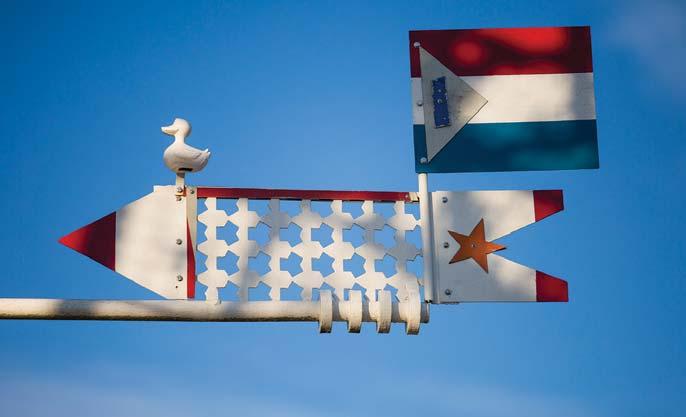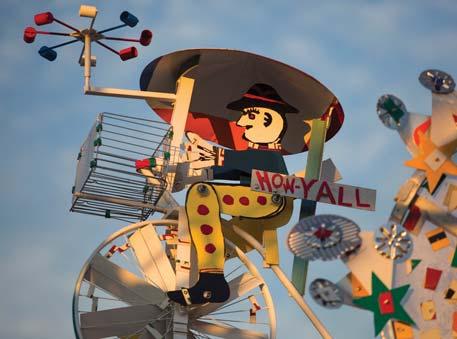
3 minute read
THROUGH THE LENS
THROUGH the LENS GIVE it a WHIRL
The Vollis Simpson Whirligig Park
Advertisement
words by SAMANTHA GRATTON
photographs by MADELINE GRAY
WINDMILLS
Originally found along the pond on Vollis Simpson’s land in Wilson County, these whirligigs, which he simply called “windmills” are full of recycled materials, road signs, and reflective metals. The intriguing structures brought visitors from across the region to see it. “If you went during the day, he would be out there. Lots of people would stop and talk to him,” says Jeff Bell, executive director at Vollis Simpson Whirligig Park and Museum, who first visited the whirligigs as a child. D Drive into Wilson to visit the Whirligig Park, and you won’t know where to look first – or, frankly, just what it is you’re seeing.
After watching the giant pinwheels spin and turn with the breeze, you start to pick up on the details, realizing each individual fan, motor, and metal that makes up the whirligig.
As it glints in the sun or reflects surrounding lights in the evening, this array of recycled materials exhibits the cluttered, fantastical chaos of a carnival.
It also reveals the quiet beauty of a man’s life story. North Carolina native and artist Vollis Simpson created dozens of intricate whirligigs before he died in 2013. Celebrated as the official folk art of the state, more than 30 whirligigs now dwell in the newly opened Vollis Simpson
Whirligig Park in historic downtown Wilson. Because Simpson’s materials were sourced locally, the park is both the work of a local artist on display and a piece of North
Carolina history.


FRESHENED UP
Before the park opened, the whirligigs were relocated from Simpson’s property to be restored. “Vollis would use spray paint or whatever was on hand, but some of the ball bearings and paint have been replaced with higher quality,” says Bell. The process took seven years prior to the park’s grand opening in November, and restoration work is still being done on smaller whirligigs which will go to various museums. Not only was the whirligigs’ integrity kept intact, but the layout of the park is modeled after their location on Simpson’s land, now circling around the amphitheater instead of his pond.

SPEAKS FOR ITSELF
Most of the whirligigs are named exactly as you might describe them. For example, the one that looks like a Christmas tree (pictured above) is called Christmas Tree. Simpson did not name any of his whirligigs himself, these were monikers given by the conservationists to serve as a reference.



AUTOBIOGRAPHICAL
Simpson was a pilot who served in the Army Air Corps during World War II. He made several whirligigs resembling World War II-era airplanes (pictured opposite top right), as well as lumberjacks and farm animals he would have likely seen in his daily life (pictured above and opposite top left). “The more you know about him and his work, the more autobiographical they are,” says Jeff Bell, executive director at Vollis Simpson Whirligig Park and Museum.
From farm machinery and fan blades to motor parts and road signs, many of these items were commonly found in or near Wilson County.





MODERN ITERATIONS
At night, people would come to Simpson’s land to experience the magic of their car headlights hitting all of the different reflectors as they spun and turned in the wind. Now, if you visit the Whirligig Park after dark, different stations are located throughout the park with a button to adjust the lights and mimic the effect of headlights shining on the whirligigs.
Near the park is another development called Whirligig Station, set to open this spring, which will include 90 apartments, a restaurant, and the whirligig museum.













